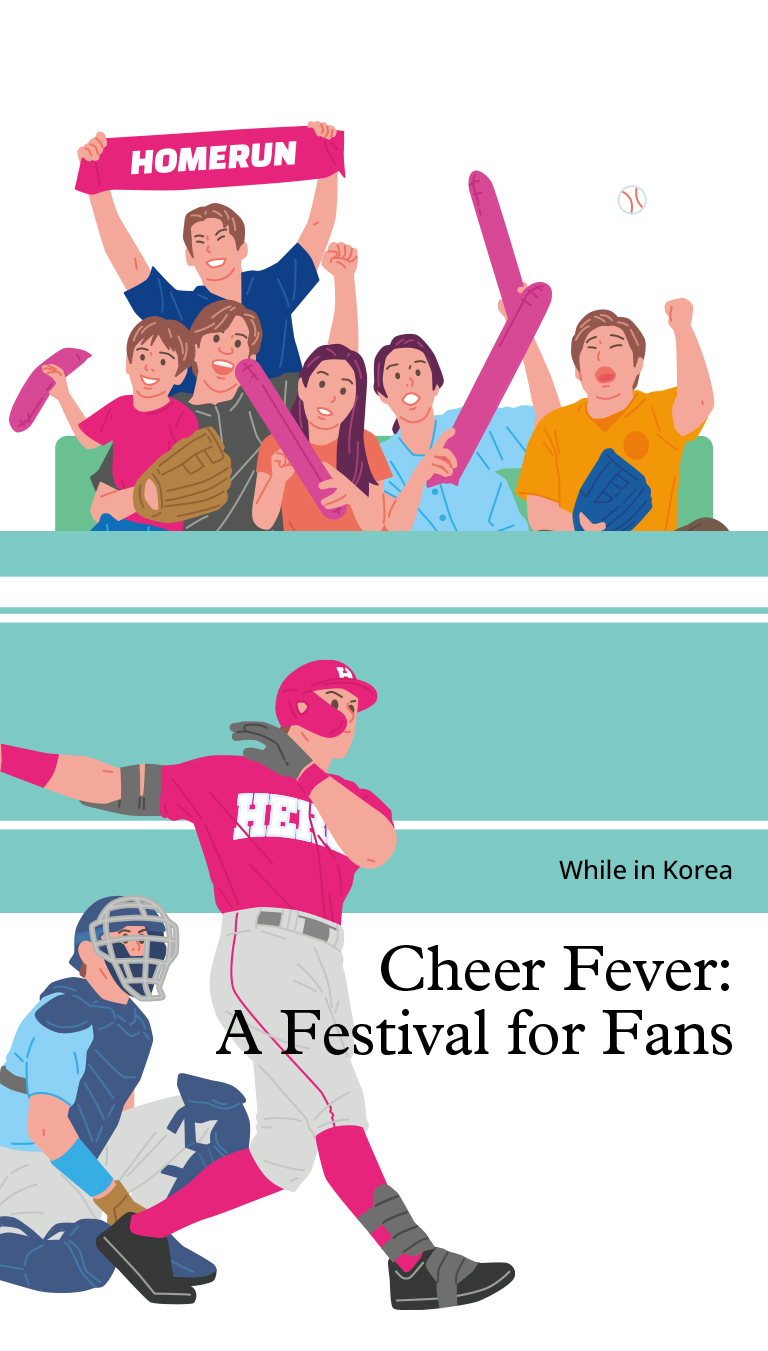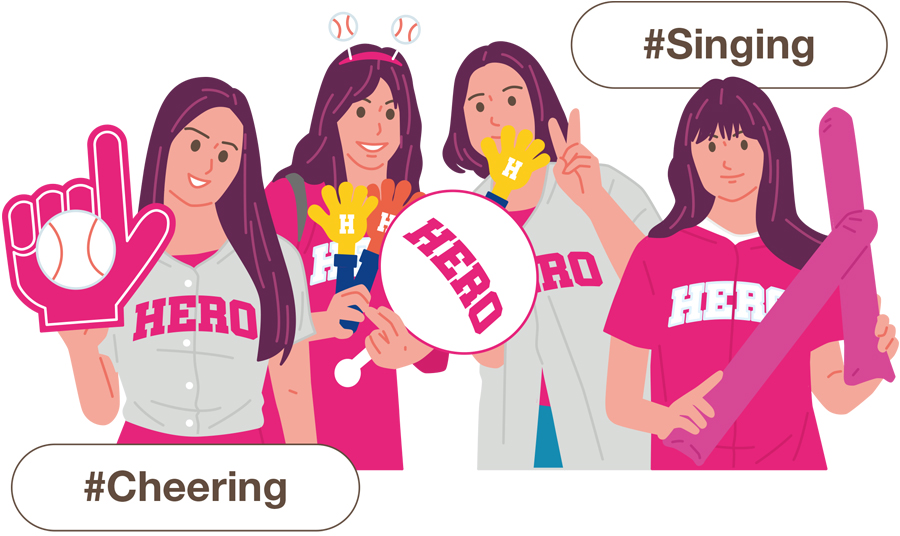
One surprising aspect of Korean culture for many visitors is the culture of cheering at sports games. This isn’t just about chanting a slogan—Korean fans sing fight songs, perform choreographed dances, deck themselves out in team gear, enjoy stadium feasts and immerse themselves in all kinds of special events. If you go to just one game, you’ll notice right away that Korea takes its cheering culture to the next level, making it a veritable art form.
Writer. Sung Ji Yeon
Illustrator. RYUGOON
Cheering culture in Korea is exemplified by professional baseball. The vibe at a Korean ball game is quite different from what foreign visitors are accustomed to. Korean fans take great pleasure in the act of cheering, whether their team wins or loses. Sports stadiums here are never quiet: fans are always singing, dancing, chanting and jumping to their feet to see the action. What’s surprising is just how nonstop the cheering is. Fans are rooting for their team from the game’s first moments until its ultimate conclusion. And there are so many different ways to cheer on your team and appreciate other people’s efforts. With all that cheering, there’s never a dull moment in the game. Basically, cheering is an experience of its own—another kind of content to consume.
In Korean stadiums in particular, there’s a song for virtually every contingency that may arise in a game. Before the game begins, spectators get pumped up by singing their team’s theme song. Whenever the team scores a run or gains the lead, fans show their unity by singing a fight song. There are songs for each athlete, and there are chants aimed at distracting the other team. In Busan, for example, fans of the home team chant the simple slogan ma (a bit of local dialect roughly equivalent to “hey”). One unique characteristic of Korea’s cheering culture is that total strangers are united in their passion for the game.
Another key element of Korea’s cheering culture to be considered is cheerleading. Cheering squad members put on a number of performances during games, such as the “Pikki Pikki” dance that went viral on social media. That dance is performed when the favored team strikes out an opposing batter. The catchy rhythm and simple choreography contributed significantly to its widespread popularity. Watching the cheerleaders is an enjoyable way to enhance the excitement of a game and helps spectators engage more fully with the experience.
Dining is another crucial part of Korea’s cheering culture. Sports fans are fond of chowing down at sporting arenas around the world, of course. But once again, Koreans raise the bar. Most baseball stadiums have special seats for serious eaters—including those who want to grill up some BBQ as they watch the game. You can count on there being delivery options of all kinds around the stadium. Plus, every stadium is famous for a certain dish, often a local specialty. Some stadiums even prepare lists of must-try foods. Noshing on some good eats during a game is so fun that some people admit the food is the real reason they show up at the stadium to cheer.

Korea’s cheering culture serve a means of uniting the spectators at a game. For example, popular athletes are chosen each year through fan voting and coach recommendations. Then those athletes are divided into two teams for a sporting extravaganza called the KBO All-Star Game. That’s a day when fans of various teams come together to sing each other’s fight songs, even after the game is over. It’s an example of truly marvelous sportsmanship grounded in mutual respect, regardless of which players do well or poorly.
Even casual sports fans like to attend games so they can enjoy the passion and positive vibes radiating from the other spectators. Sure enough, there was a big jump in the number of foreign tourists who attended a Korean sports game in 2024. Foreign athletes who have played in Korea’s pro leagues say that cheering culture left the biggest impression on them. The New York Times even printed an article called “‘Get Ready to Scream’: How to Be a Baseball Fan in South Korea.”
Korea’s cheering culture is loved by fans, players, and all ages, raising the question of its origins. One can assume that Koreans’ basic temperament played a big role here. Amid the rapid growth that followed the Korean War in the 1950s, the Korean nation prioritized unity. One factor was the basic Confucian order undergirding society; another was the premium placed on “pulling together” and “sharing the load.” Combined with Koreans’ abundant energy and innate heung, or infectious enthusiasm and excitement, that resulted in the passionate cheering culture seen today.
One way to see this is as an expansion of fan culture into the world of sports. Although the enthusiastic supporters of K-pop idols are probably the best-known, Korean fandoms proliferate nearly every aspect of society. Fandom members are absolutely loyal and take great pleasure in showing their support. That may have bled over into sports cheering culture.
The sheer joy of Korean cheering culture has to be seen to be believed. If you have a chance, make sure to join the crowds bound for a Korean sporting venue. You don’t need to be knowledgeable about the sport itself. As long as you familiarize yourself with how cheering works here, you can anticipate having a fantastic time in the festive mood that lasts every moment of the game.
